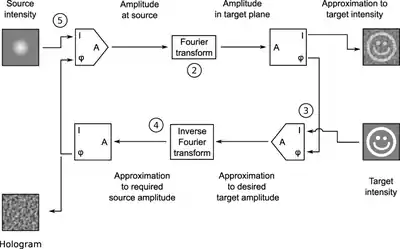Phase retrieval
Phase retrieval is the process of algorithmically finding solutions to the phase problem. Given a complex signal , of amplitude , and phase :
where x is an M-dimensional spatial coordinate and k is an M-dimensional spatial frequency coordinate. Phase retrieval consists of finding the phase that satisfies a set of constraints for a measured amplitude. Important applications of phase retrieval include X-ray crystallography, transmission electron microscopy and coherent diffractive imaging, for which .[1] Uniqueness theorems for both 1-D and 2-D cases of the phase retrieval problem, including the phaseless 1-D inverse scattering problem, were proven by Klibanov and his collaborators (see References).
Methods
Error reduction algorithm

The error reduction is a generalization of the Gerchberg–Saxton algorithm. It solves for from measurements of by iterating a four-step process. For the th iteration the steps are as follows:
Step (1): , , and are estimates of, respectively, , and . In the first step we calculate the Fourier transform of :
Step (2): The experimental value of , calculated from the diffraction pattern via the signal equation, is then substituted for , giving an estimate of the Fourier transform:
where the ' denotes an intermediate result that will be discarded later on.
Step (3): the estimate of the Fourier transform is then inverse Fourier transformed:
Step (4): then must be changed so that the new estimate of the object, , satisfies the object constraints. is therefore defined piecewise as:
where is the domain in which does not satisfy the object constraints. A new estimate is obtained and the four step process is repeated.
This process is continued until both the Fourier constraint and object constraint are satisfied. Theoretically, the process will always lead to a convergence,[1] but the large number of iterations needed to produce a satisfactory image (generally >2000) results in the error-reduction algorithm by itself being unsuitable for practical applications.
Hybrid input-output algorithm
The hybrid input-output algorithm is a modification of the error-reduction algorithm - the first three stages are identical. However, no longer acts as an estimate of , but the input function corresponding to the output function , which is an estimate of .[1] In the fourth step, when the function violates the object constraints, the value of is forced towards zero, but optimally not to zero. The chief advantage of the hybrid input-output algorithm is that the function contains feedback information concerning previous iterations, reducing the probability of stagnation. It has been shown that the hybrid input-output algorithm converges to a solution significantly faster than the error reduction algorithm. Its convergence rate can be further improved through step size optimization algorithms.[2]
Here is a feedback parameter which can take a value between 0 and 1. For most applications, gives optimal results.{Scientific Reports volume 8, Article number: 6436 (2018)}
Shrinkwrap
For a two dimensional phase retrieval problem, there is a degeneracy of solutions as and its conjugate have the same Fourier modulus. This leads to "image twinning" in which the phase retrieval algorithm stagnates producing an image with features of both the object and its conjugate.[3] The shrinkwrap technique periodically updates the estimate of the support by low-pass filtering the current estimate of the object amplitude (by convolution with a Gaussian) and applying a threshold, leading to a reduction in the image ambiguity.[4]
Applications
Phase retrieval is a key component of coherent diffraction imaging (CDI). In CDI, the intensity of the diffraction pattern scattered from a target is measured. The phase of the diffraction pattern is then obtained using phase retrieval algorithms and an image of the target is constructed. In this way, phase retrieval allows for the conversion of a diffraction pattern into an image without an optical lens.
Using phase retrieval algorithms, it is possible to characterize complex optical systems and their aberrations.[5] Other applications of phase retrieval include X-ray crystallography and transmission electron microscopy.
See also
References
- Fienup, J. R. (1982-08-01). "Phase retrieval algorithms: a comparison". Applied Optics. 21 (15): 2758–69. doi:10.1364/AO.21.002758. ISSN 0003-6935. PMID 20396114.
- Marchesini, S. (25 January 2007). "Invited Article: A unified evaluation of iterative projection algorithms for phase retrieval". Review of Scientific Instruments. 78 (1): 011301. arXiv:physics/0603201. doi:10.1063/1.2403783. ISSN 0034-6748. PMID 17503899.
- Fienup, J. R.; Wackerman, C. C. (1986-11-01). "Phase-retrieval stagnation problems and solutions". Journal of the Optical Society of America A. 3 (11): 1897. doi:10.1364/JOSAA.3.001897. ISSN 1084-7529.
- Marchesini, S.; He, H.; Chapman, H. N.; Hau-Riege, S. P.; Noy, A.; Howells, M. R.; Weierstall, U.; Spence, J. C. H. (2003-10-28). "X-ray image reconstruction from a diffraction pattern alone". Physical Review B. 68 (14): 140101. arXiv:physics/0306174. doi:10.1103/PhysRevB.68.140101. ISSN 0163-1829.
- Fienup, J. R. (1993-04-01). "Phase-retrieval algorithms for a complicated optical system". Applied Optics. 32 (10): 1737–1746. doi:10.1364/AO.32.001737. ISSN 2155-3165. PMID 20820307.
- Klibanov, M. V. (1985). "On uniqueness of the determination of a compactly supported function from the modulus of its Fourier transform". Soviet Mathematics - Doklady. 32: 668–670.
- Klibanov, M.V. (1987). "Determination of a function with compact support from the absolute value of its Fourier transform and an inverse scattering problem". Differential Equations. 22: 1232–1240.
- Klibanov, M.V. (1987). "Inverse scattering problems and restoration of a function from the modulus of its Fourier transform". Siberian Math J. 27 (5): 708–719. doi:10.1007/bf00969199.
- Klibanov, M. V. (1989). "Uniqueness of the determination of distortions of a crystal lattice by the X-ray diffraction in a continuous dynamical model". Differential Equations. 25: 520–527.
- Klibanov, M.V. & Sacks, P.E. (1992). "Phaseless inverse scattering and the phase problem in optics". J. Math. Phys. 33 (11): 2813–3821. Bibcode:1992JMP....33.3813K. doi:10.1063/1.529990.
- Klibanov, M. V.; Sacks, P.E. (1994). "Use of partial knowledge of the potential in the phase problem of inverse scattering". J. Comput. Phys. 112 (2): 273–281. Bibcode:1994JCoPh.112..273K. doi:10.1006/jcph.1994.1099.
- Klibanov, M. V.; Sacks, P.E.; Tikhonravov, A.V. (1995). "The phase retrieval problem". Inverse Problems. 11 (1): 1–28. Bibcode:1995InvPr..11....1K. doi:10.1088/0266-5611/11/1/001.
- Klibanov, M. V. (2006). "On the recovery of a 2-D function from the modulus of its Fourier transform". J. Math. Anal. Appl. 323 (2): 818–843. doi:10.1016/j.jmaa.2005.10.079.